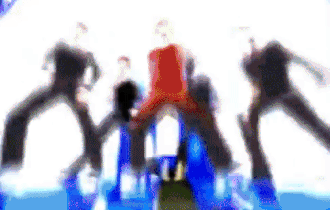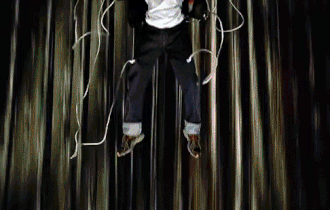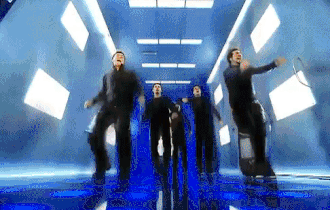Released: 28th February 2000
Writers: Kristian Lundin / Jake Schulze / Andreas Carlsson
Peak position: #3
Chart run: 3-8-11-20-28-37-44-58
Chart run (2024): 30-12-13-12-18-20-23-29-63-56-64-62-74-
Billboard Hot 100 chart run: 42-20-19-14-13-7-6-5-5-5-5-4-4-6-6-7-9-12-18-20-27-34-40
*NSYNC’s success had been building slowly throughout the late ‘90s – what they needed now was a song that would shatter the glass ceiling and put them on pop’s A-list. And it came in the shape of Bye Bye Bye.

In the lead-up to the release of this single, *NSYNC were embroiled in a legal dispute with their former record label RCA and manager Lou Pearlman over embezzled profits from their debut album. Even without that as a factor, the switch to Jive Records was a sensible one; home to Backstreet Boys and Britney Spears, the label had strong links with Cheiron Studios and knew exactly how to package and sell a single. If there was a chance of *NSYNC elevating their fame further, then Jive was the best place to do it.

And true to form, they came up with the goods. Bye Bye Bye was a watershed moment, but it almost happened quite differently. The song was originally offered to Five, who disliked and rejected it (the group who also passed on …Baby One More Time). Whether by fate or by fluke, Bye Bye Bye found its way to *NSYNC, propelling the group to a level of success that few could have foreseen; particularly in the UK, where they had largely flown under the radar up until this point.

The single arrived at the perfect time to ride the crest of the Cheiron wave kickstarted by …Baby One More Time and I Want It That Way the previous year. Bye Bye Bye was recognisably from the same stable, but distinctive enough to give *NSYNC their own identity, with a harder, spikier sound and more frenetic energy than the material of their new label-mates. It was an essential stage in the evolution of the Cheiron sound from songs like Larger Than Life into Stronger and The Call.

The track was incredibly fitting for *NSYNC’s narrative in terms of their parting ways with Lou Pearlman – which they referenced directly with the title of the album: No Strings Attached. That same notion was extended through to the single. The lyrics, although not composed in relation to the group’s legal battle, certainly took a new meaning and there’s no denying that the barbed delivery of lines like: “I’m doing this tonight, you’re probably gonna start a fight” and: “So now it’s time to leave and make it alone” seems more directed than your average break-up anthem.

The velocity at which Bye Bye Bye plays out is still without parallel; Kristian Lundin would later reveal that the song was composed as a production piece, which would explain why it manages to maintain such frantic energy rather than giving the lyrics room to breathe. The track plays to *NSYNC’s strengths in terms of their dynamic and having two distinct lead vocalists in JC Chasez and Justin Timberlake. Both would later prove their worth as solo artists, but Bye Bye Bye was an early example of the ease with which both singers could competently match an urgent production with a slick, cohesive delivery to provide maximum impact. The “BYE BYYYYYYYYYYYE, BABY” transition into the final chorus is utterly tremendous, literally shattering the core of pop music as we knew it – and would later lend itself to a self-referential moment in Crossroads starring Britney Spears.

Of course, if Bye Bye Bye was to register on the same level as Jive’s previous efforts, then it needed a striking visual to accompany it. And boy, did it get one. Directed by Wayne Isham – who was working closely with Backstreet Boys and 98 Degrees at the time – the music video is one made for the gif/meme generation a decade and a half before it existed. It effortlessly permeated popular culture (more so in America, admittedly), having been referenced and parodied numerous times in the years since it was released. Despite consisting of a series of largely isolated sequences tenuously linked together, the video never feels like a calculated attempt to secure heavy rotation on MTV – even though that’s exactly what it was. Bye Bye Bye packs an impressive number of immediately recognisable elements into four minutes: the shots of *NSYNC as puppets (a visual that would again carry through to No Strings Attached); the fierce dancing in the blue cell; the climactic car chase. The fact that there’s a whole chase sequence atop a train and it’s one of the less memorable moments of the video just underlines how big a project this was and how successfully it was realised. The distorted, rotating shots of *NSYNC dancing are so full of energy and attitude that it really felt like the group was raising the benchmark for their peers.
I’m giving up, I know for sure
I don’t wanna be the reason for your love no more
Bye, bye
I’m checkin’ out, I’m signin’ off
I don’t wanna be the loser and I’ve had enough
Bye Bye Bye is one of those singles completely synonymous with the summer of 2000, where it felt like every act was firing on all cylinders and dominating the chart. Yet, the track was actually released in March and didn’t reach #1 in the UK or America. However, the single was part of something much bigger; and nowhere was that more evident than No Strings Attached selling 2.4 million copies in its first week on sale in America (it sold 1.1 million copies on the first day alone). Arguably, this is the moment pop music reached both an exhilarating peak and saturation point.

Although they were smashing records in America, the response to *NSYNC in the UK was a little more muted. Bye Bye Bye was a top three hit and played ad nauseum on MTV and The Box; however, the group never managed to translate or consolidate that success in the same way as their peers, and thus No Strings Attached peaked at a modest #14 here.

Nonetheless, Bye Bye Bye is certainly far better remembered than its chart run would suggest. Although clearly driven by events occurring behind the scenes, the single defiantly positioned the group as survivors, not victims, and faultlessly relaunched *NSYNC as an A-list pop act.



